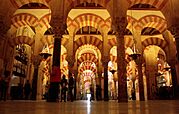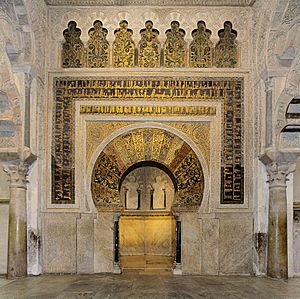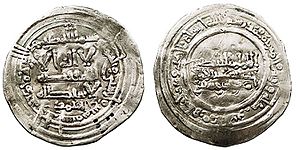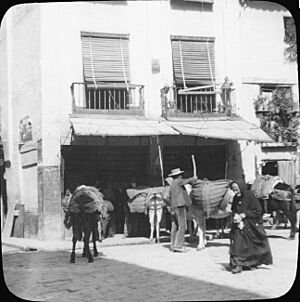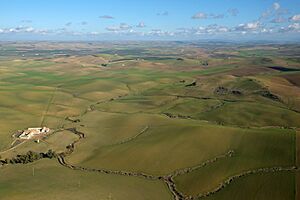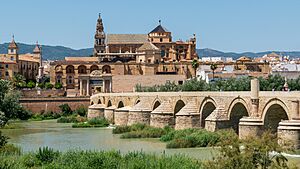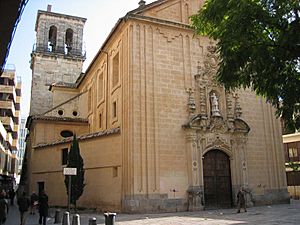Córdoba, Spain facts for kids
Quick facts for kids
Córdoba
Cordova
|
|||||||||||||
|---|---|---|---|---|---|---|---|---|---|---|---|---|---|
|
View centred on the city's historic center in relation to the Guadalquivir, with Sierra Morena in the background (November 2020)
Calleja de las Flores
|
|||||||||||||
|
|||||||||||||
| Nicknames:
La Ciudad Califal, Córdoba la Llana
|
|||||||||||||
| Country | Spain | ||||||||||||
| Autonomous community | Andalusia | ||||||||||||
| Province | Córdoba | ||||||||||||
| Government | |||||||||||||
| • Type | Ayuntamiento | ||||||||||||
| • Body | Ayuntamiento de Córdoba | ||||||||||||
| Area | |||||||||||||
| • Total | 1,253 km2 (484 sq mi) | ||||||||||||
| Elevation | 106 m (348 ft) | ||||||||||||
| Population
(2018)
|
|||||||||||||
| • Total | 325,708 | ||||||||||||
| • Density | 259.94/km2 (673.25/sq mi) | ||||||||||||
| Demonyms | Cordoban, (Spanish: cordobés/sa, cordobense, cortubí, patriciense) | ||||||||||||
| GDP | |||||||||||||
| • Metro | €13.070 billion (2020) | ||||||||||||
| Time zone | UTC+1 (CET) | ||||||||||||
| • Summer (DST) | UTC+2 (CEST) | ||||||||||||
| Postal code |
14001–14014
|
||||||||||||
|
|||||||||||||
Córdoba is a beautiful city in Andalusia, Spain. It is the capital of the province of Córdoba. This city is the third largest in Andalusia.
Córdoba is mostly located on the right bank of the Guadalquivir river. This river runs through the south of the Iberian Peninsula. The city was first a Roman settlement. Later, it was taken over by the Visigothic Kingdom. In the 8th century, it was conquered by Muslims.
Córdoba became the capital of the Caliphate of Córdoba. From here, the Umayyad dynasty ruled a large part of Spain until 1031. Under their rule, Córdoba became a famous place for education and learning. By the 10th century, it was the second-largest city in Europe.
After a period of change, Christian forces took over Córdoba in 1236. It then became part of the Crown of Castile.
Córdoba is known for its amazing Moorish architecture. A great example is the Mezquita-Catedral. This building was named a UNESCO World Heritage Site in 1984. It is now a cathedral. The entire historic centre of Córdoba is also a World Heritage Site. Near the city, Madinat al-Zahra is another World Heritage Site. The Festival de los Patios is also recognized by UNESCO.
Córdoba has some of the hottest summer temperatures in Spain and Europe. Average high temperatures are around 37°C (99°F) in July and August. Summers are very dry, but winters are mild with frequent rain.
Contents
What's in a Name?
The name Córdoba has an interesting history. One idea is that it comes from the Punic language. Qart ṭūbah means "good town." The city was founded when the Carthaginians were in Spain.
After the Romans took over, the name became Corduba. During Muslim rule, the city was known in Arabic as Qurṭubah.
A Look Back in Time
Early Days and Roman Rule
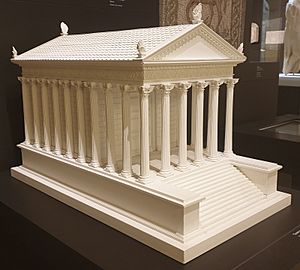
People have lived in the Córdoba area for a very long time. The first signs of humans here are from about 42,000 to 35,000 BC. Early settlements existed around the Guadalquivir river from the 8th century BC. People in this area learned to work with copper and silver.
The Carthaginians expanded into this area. Córdoba was later conquered by the Romans in 206 BC.
In 169 BC, a Roman leader named Marcus Claudius Marcellus founded a new settlement. It was next to the older one. The famous Cordoba Treasure, a mix of local and Roman art, was buried here. It is now in the British Museum.
Córdoba became an important Roman city called Colonia Patricia. This happened between 46 and 45 BC. It was the capital of Baetica, a Roman province. It was a main center for Roman thinkers in Spain. Famous Roman thinkers like Seneca the Younger came from Córdoba.
Under Muslim Rule
Córdoba was taken by Muslims in 711 or 712. It became a provincial capital in 716. The city was known as Qurṭuba in Arabic.
The old Roman and Visigothic parts of the city became the walled medina. Over time, many suburbs grew around the city.
In 756, Abd ar-Rahman I, a surviving Umayyad leader, came to Spain. He made Córdoba his capital and started his own dynasty. In 785–786, he ordered the building of the Great Mosque of Córdoba. This mosque was completed the next year. It was expanded later by other rulers.
Córdoba grew into one of the most advanced cities in the world in the 10th and 11th centuries. It was a major center for culture, politics, and trade.
The city had a strong economy. It made goods like leather, metalwork, and textiles. It also grew many fruits, vegetables, and spices. Córdoba was also famous for learning. It had over 80 libraries and schools. Knowledge of medicine, math, astronomy, and plants was far ahead of the rest of Europe.
In 929, Abd al-Rahman III declared himself "caliph". This made Córdoba even more powerful in the 10th century. During this time, two palace-cities were built nearby. These were Madinat al-Zahra and another one by al-Mansur. Córdoba's peak ended after a crisis in 1009.
Later Middle Ages
After the caliphate ended in 1031, Córdoba became an independent state. Its power did not extend far from the city.
In 1236, Ferdinand III of Castile entered the city after a siege. The Great Mosque was then changed into a Catholic cathedral. It was dedicated to the Virgin Mary. The city was divided into 14 areas, and many new churches were built.
Modern Times
Between 1530 and 1580, Córdoba had a "golden age." It grew rich from farming and making clothes. The city's population reached about 50,000 by 1571. After this, it went through a period of decline.
The population and economy started to grow again in the early 20th century. In the late 1800s, railway transport arrived. Córdoba was connected to other major Spanish cities like Seville and Madrid.
On July 18, 1936, a military coup began in the city. This event started the Spanish Civil War. The city was taken over by the Nationalist forces.
The Mosque-Cathedral was declared a UNESCO World Heritage Site in 1984. In 1994, this status was given to the entire historic centre of Córdoba. Today, Córdoba has many modern areas, especially around the railway station.
Where is Córdoba?
Córdoba is in the south of Spain. It lies in the Guadalquivir depression, which is a valley formed by the Guadalquivir river. The river flows through the city. The city's area is about 1,254 square kilometers (484 square miles). This makes it the largest municipality in Andalusia.
The city itself is about 125 meters (410 feet) above sea level. To the north, the Sierra Morena mountains rise up. To the south, the land is gently hilly. Both areas offer great views of the valley.
What's the Weather Like?
Córdoba has a hot Mediterranean climate. It has the highest average summer temperatures in Spain and Europe. Highs often reach 37°C (99°F) in July. Days over 40°C (104°F) are common in summer. This happens because of its location in the Guadalquivir Valley. This valley is one of the hottest summer regions in Europe.
Winters are mild. They are cooler than other cities in southern Spain because Córdoba is inland. Rain mostly falls in the colder months, from December to February. This is typical for a Mediterranean climate. The yearly rainfall is usually over 600 mm (24 inches).
The highest temperature ever recorded at Córdoba Airport was 46.9°C (116.4°F). This happened on July 13, 2017, and August 14, 2021. The lowest temperature recorded was -8.2°C (17.2°F) on January 28, 2005.
Amazing Landmarks
The historic centre of Córdoba has been a UNESCO World Heritage Site since 1994.
Roman Sights
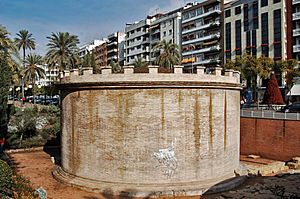
The Roman Bridge crosses the Guadalquivir River. It connects different parts of the city. For 20 centuries, it was the only bridge in Córdoba. It was first built in the early 1st century BC. It was rebuilt in the 8th century under Muslim rule. It is about 250 meters (820 feet) long and has 16 arches.
Other Roman remains include the Roman Temple. There are also parts of a Theatre, a Mausoleum, and a Roman forum. You can also see remains of Emperor Maximian's Palace.
Islamic Treasures
Great Mosque of Córdoba

From 784-786 AD, Abd al-Rahman I built the Great Mosque of Córdoba. It is one of the most famous examples of Western Islamic architecture. It blended Islamic styles with Roman and Visigothic elements. Later Muslim rulers expanded the mosque. They added a minaret and made the prayer hall bigger. A major expansion in the 10th century added the beautiful mihrab and other decorations.
After the Christian conquest, the mosque became a cathedral. It was changed a lot in the 16th century. However, much of the original building is still there. It became a World Heritage Site in 1984.
Minaret of San Juan
This minaret was built in 930 AD. The mosque it belonged to was replaced by a church. The minaret is now used as a church tower. It still shows features of Islamic architecture, like its double horseshoe-arch windows.
Mills on the Guadalquivir
Along the Guadalquivir river, you can find the Mills of the Guadalquivir. These are watermills from different times. They used the river's power to grind flour. Some of them are the Albolafia, Alegría, and Carbonell mills.
Calahorra Tower
The Calahorra is a strong tower at the south end of the Roman Bridge. It was likely built during the Almohad period. Today, it houses the Al-Andalus Living Museum. This museum shows the cultural achievements of the Al-Andalus period.
Caliphal Baths
Near the Alcázar de los Reyes Cristianos, you can find the Caliphal Baths. These are partly rebuilt baths from the 10th century. They were expanded later. This archaeological site has been a museum since 2006.
Medina Azahara
Just outside the city is the ancient palace-city of Madinat al-Zahra. It was built in the 10th century. It is another great example of Islamic architecture in Spain. It has been excavated and rebuilt since 1911.
Jewish Quarter
Near the cathedral is the old Jewish quarter. It has many winding streets that still look medieval. Here, you can find the Sepharad House museum. There is also the Synagogue, built in 1315.
Christian Sights
The Roman walls surround the Old Town. Some gates remain, like the Puerta de Almodóvar and the Puerta del Puente. Towers like the Malmuerta Tower are also still standing.
In the south of the Old Town is the Posada del Potro. This is a group of inns mentioned in famous books like Don Quixote. They were active until 1972. The name comes from a fountain in the plaza that shows a foal (potro).
The Alcázar de los Reyes Cristianos is in the southwest of the Old Town. It was once a royal property. Next to it are the Royal Stables, where Andalusian horses are bred. Other palace buildings include the Palacio de Viana (14th century).
Fernandine Churches
Córdoba has 12 Christian churches built by Ferdinand III of Castile. This was after he took the city back in the 13th century. Many of these churches were built from former mosques. They served as both churches and administrative centers for the city's neighborhoods. Some of them are:

- San Nicolás de la Villa.
- San Miguel.
- San Juan y Todos los Santos.
- Santa Marina de Aguas Santas.
- San Agustín. This church was started in 1328. Its bell tower is from the 16th century.
- San Andrés. It was largely updated in the 14th and 15th centuries.
- San Lorenzo.
- Church of Santiago.
- San Pedro.
- Santa María Magdalena. It mixes Romanesque, Mudéjar, and Gothic styles.
- San Pablo. Ruins of an ancient Roman circus were found in its garden.
Other Religious Buildings
- Iglesia de San Hipólito. It holds the tombs of kings Ferdinand IV and Alfonso XI of Castile.
- Iglesia de San Francisco
- Santuario de Nuestra Señora de Linares
- Chapel of San Bartolomé
- Convent of Santa Clara
Statues and Memorials
Around the city, you can find ten statues of the Archangel Raphael. He is seen as the protector of Córdoba. These are called the Triumphs of Saint Raphael. They are in places like the Roman Bridge and the Plaza del Potro.
In the Historic Centre, there are statues of famous thinkers. These include Seneca the Younger, Averroes, and Maimonides. Inside the Alcázar de los Reyes Cristianos, there is a monument to the Catholic Monarchs and Christopher Columbus.
Other sculptures are in the city's plazas. In Plaza de las Tendillas, there is a statue of Gonzalo Fernández de Córdoba. In Plaza de Capuchinos, you can see the Cristo de los Faroles.
Bridges
- San Rafael Bridge. This bridge has eight arches and is 217 meters (712 feet) long. It was opened in 1953.
- Andalusia Bridge, a suspension bridge.
- Puente de Miraflores, also called "the rusty bridge." It was opened in 2003.
- Abbas Ibn Firnas Bridge. This bridge opened in 2011.
Gardens, Parks, and Nature
- Jardines de la Victoria. These gardens have a modern fountain and a neoclassical pergola.
- Jardines de la Agricultura. This park has many paths and a pond with ducks. It also has sculptures of famous people.
- Parque de Miraflores. This park is on the south bank of the Guadalquivir river.
- Parque Cruz Conde. This is an open park in the style of an English garden.
- Paseo de Córdoba. This is a long path built over underground train tracks. It has many fountains.
- Parque de la Asomadilla. At 27 hectares (67 acres), it is the second largest park in Andalusia. It has Mediterranean plants and trees.
- Sotos de la Albolafia. This area along the Guadalquivir river is a Natural Monument. It is home to many birds and is important for bird migration.
Museums to Explore
The Archaeological and Ethnological Museum of Córdoba is near the Guadalquivir River. It opened in 1867. The museum has eight halls. They show items from the Bronze Age, Roman times, Visigothic art, and Islamic culture.
The Julio Romero de Torres Museum is next to the Guadalquivir. It opened in 1931. This museum is the former home of the artist Julio Romero de Torres. It displays many of his paintings.
The Fine Arts Museum of Córdoba shares a courtyard with the Julio Romero de Torres Museum. It was once a hospital. The museum has many works from the Baroque period, medieval art, and art from the 18th, 19th, and 20th centuries.
The Diocesan Museum is in the Córdoba's Episcopal Palace. This palace was built on the site of an old Muslim palace. The museum's collection includes paintings, sculptures, and furniture.
You can also visit the Caliphal Baths as a museum.
Fun Festivals
Tourism is very popular in Córdoba in May. This month has three of the city's most important yearly festivals:
- Las Cruces de Mayo (The May Crosses of Córdoba). This festival happens at the start of May. Large crosses, about 3 meters (10 feet) tall, are placed in squares and streets. They are decorated with flowers. A contest is held to find the most beautiful cross. You can often find local food and music near the crosses.
- Los Patios de Córdoba (The Courtyards Festival of Córdoba - World Heritage). This festival is celebrated during the second and third weeks of May. Many houses in the historic center open their private courtyards to the public. They compete in a contest. The beauty of the architecture and the flower decorations are judged. It can be hard to find a place to stay in the city during this festival.
- La Feria de Córdoba (The Fair of Córdoba). This festival takes place at the end of May. It is similar to the famous Seville Fair. The main difference is that Córdoba's fair has more public casetas (tents run by local businesses).
Famous People from Córdoba
Many notable people come from Córdoba, including:
- Averroes – a famous Islamic philosopher.
- Joaquín Cortés – a talented Flamenco artist.
- Luis de Góngora – a well-known Renaissance-era poet.
- Maimonides – a respected Jewish philosopher and rabbi.
- Manolete – a famous matador.
- Paco Peña – a skilled Flamenco artist.
- Julio Romero de Torres – a famous painter.
- Seneca – a Roman philosopher.
Sports in Córdoba
Córdoba's main sports team is its football team, Córdoba CF. They play in the Spanish LaLiga HyperMotion. Their home matches are played at the Estadio Nuevo Arcángel, which has over 20,000 seats.
Córdoba also has a professional futsal (indoor football) team. This team is called Cordoba Patrimonio de la Humanidad. They play in the Primera División de Futsal. Most of their home games are played at the Palacio Municipal de Deportes Vista Alegre.
Getting Around
By Train
The Córdoba railway station is connected by high-speed trains. You can reach Spanish cities like Madrid, Barcelona, Seville, and Málaga. More than 20 trains a day connect the city center to Málaga in just 54 minutes. From Málaga, you can connect to places along the Costa del Sol.
By Air
Córdoba has an airport, but it does not have regular commercial flights. The closest airports are Seville Airport (110 km or 68 miles away), Granada Airport (118 km or 73 miles away), and Málaga Airport (136 km or 85 miles away).
By Road
The city is well connected by highways to the rest of Spain and Portugal. The A-45 and A-4 motorways serve Córdoba.
Intercity Buses
The main bus station is next to the train station. Several bus companies offer services to and from Córdoba.
Images for kids
-
Capilla de San Bartolomé (around 1410)
-
Gardens of the Alcázar de los Reyes Cristianos
-
Roman bridge of Córdoba and Mosque-Cathedral
-
Statue of Seneca the Younger by the Puerta de Almodóvar
Twin Cities
Córdoba is twinned with many cities around the world. This means they have a special friendship and cultural exchange. Some of its twin cities include:
 Kairouan, Tunisia (1968)
Kairouan, Tunisia (1968) Lahore, Pakistan (1968)
Lahore, Pakistan (1968) Córdoba, Argentina (1969)
Córdoba, Argentina (1969) Córdoba, Mexico (1980)
Córdoba, Mexico (1980) Bukhara, Uzbekistan (1983)
Bukhara, Uzbekistan (1983) Fez, Morocco (1990)
Fez, Morocco (1990) Old Havana, Cuba (2000)
Old Havana, Cuba (2000) Damascus, Syria (2002)
Damascus, Syria (2002) Santiago de Compostela, Spain (2004)
Santiago de Compostela, Spain (2004) Nuremberg, Germany (2010)
Nuremberg, Germany (2010) Nîmes, France (2013)
Nîmes, France (2013)
See also
 In Spanish: Córdoba (España) para niños
In Spanish: Córdoba (España) para niños



